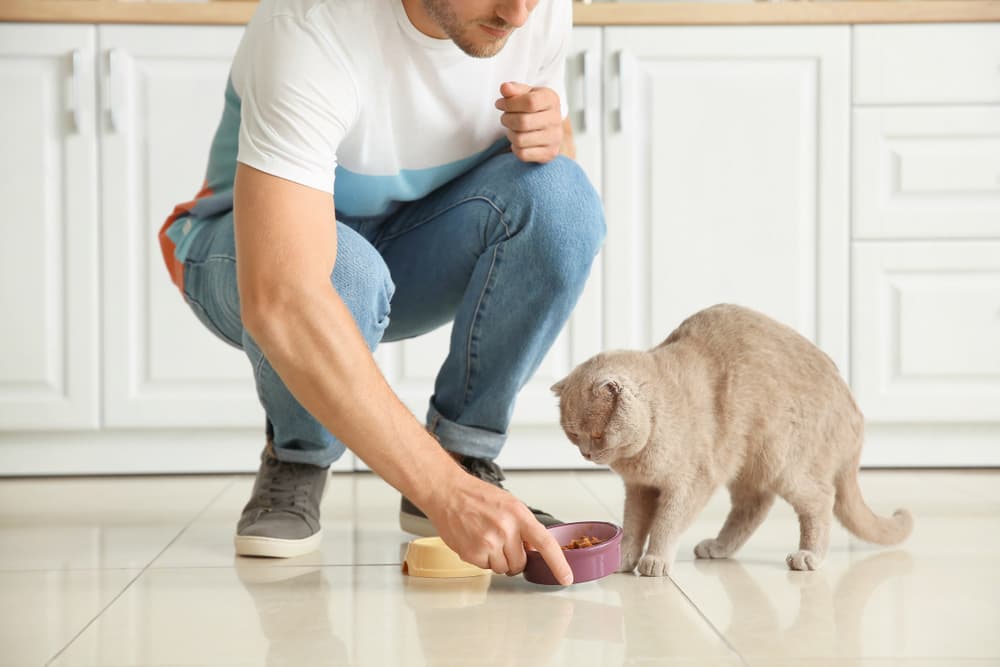Pumpkin for Cats: 3 Ways to Use It

If you have a dog, you might have heard that feeding pumpkin can help with digestive issues like diarrhea and constipation, but what about cats? Can cats eat pumpkin, too?
The answer is yes! In appropriate quantities, plain, canned pumpkin can be a healthy addition to a cat’s diet. Read on to learn about the benefits of pumpkin and get suggestions for when and how to feed pumpkin to cats.
Is Pumpkin Good for Cats?

Not only is pumpkin good for cats, it’s even found in some commercial cat foods. Pumpkin is low in calories, and contains fiber and nutrients like vitamins A, C, and E. Pumpkin also contains antioxidants, which might prevent cell damage due to free radicals.
Cats are obligate carnivores, which means that the majority of their diet should come from meat. However, small amounts of other foods, including pumpkin, may be beneficial in a cat’s overall diet. Fiber is found in varying amounts in cat foods, but some cats benefit from extra fiber in their diets.
When feeding pumpkin to cats, canned pumpkin puree is the simplest option. Make sure you are using plain, canned pumpkin—not canned pumpkin pie filling, which contains sugar and other ingredients cats shouldn’t be eating. If you prefer, you could roast the flesh of a whole pumpkin, then puree it yourself. Just be sure to skip the butter, oil, and salt—plain pumpkin is all your cat needs.
Though cats can eat pumpkin seeds—roasted or raw—they could potentially be a choking hazard, so should be ground or chopped up. Cats might not enjoy eating pumpkin seeds, but many cats will eat pumpkin puree.
Benefits of Pumpkin for Cats

The soluble fiber in pumpkin offers many benefits to cats. For cats with mild diarrhea, pumpkin can absorb excess water and firm up the stools. Pumpkin can also help cats with constipation, as the fiber and moisture in pumpkin can help things move along again.
Pumpkin can have a similar effect for cats that suffer from hairballs, with the fiber in pumpkin helping to move the hair through the digestive tract.
Adding a small amount of pumpkin to your cat’s food can also help cats who need to lose some weight. The pumpkin can provide a little bulk with few calories, helping cats to feel more full and satisfied.
If your cat is suffering from digestive upset or excessive hairballs, it’s important to seek veterinary advice before attempting to treat the symptoms yourself with pumpkin.
“Cats with severe diarrhea or constipation may not respond to pumpkin,” says Dr. Emily Swiniarski, medical director of the Anti-Cruelty Society in Chicago, Illinois. Also, your cat might require additional treatment depending on what is causing the symptoms.
How Much Pumpkin to Give a Cat

Pumpkin should only be given in very small quantities—no more than 2 tablespoons daily. “This is because we do not want our cats to fill up on pumpkin and not cat food, which would cause serious imbalances in their diet,” Swiniarski says. “The cat will not have room for sources of protein that are essential to their health. Any more than 10 percent of their diet could be detrimental.”
Too much pumpkin could even have the opposite of your desired effect, potentially causing stomach upset. “If a cat eats too much pumpkin, they may vomit or have diarrhea due to the change in diet and change in fiber,” Swiniarski says.
To avoid stomach upset, start off with smaller amounts at first—about 1 teaspoon—and work your way up gradually if you don’t see results from the smaller serving. According to Swiniarski, most cat owners feed about 1 tablespoon daily to their cats.
Pumpkin for Cats: 3 Ways to Use It

If you’re ready to start adding pumpkin to your cat’s diet, here are a few ways to serve it:
Feed canned pumpkin directly
Some cats might enjoy the taste of plain, canned pumpkin. If your cat is one who does, you can let him or her lick the puree right off a spoon as a treat.
Mix canned pumpkin into food
Most cats prefer the taste of meaty foods, so pumpkin might not be their first choice for a snack. If that’s the case for your cat, it’s easy to mix pumpkin puree right into your cat’s food (wet or dry). Most cats have no problem eating pumpkin once it’s been mixed into their food.
Whip up some pumpkin cat treats
If you like to cook, search the internet for one of the many recipes for pumpkin cat treats. To entice picky cats, look for treat recipes that incorporate meat in addition to pumpkin.
Pumpkin and Cats: Other Tips and Advice

Pumpkin for cats is not a miracle food, but it can help kitties suffering from mild diarrhea or constipation, assist with hairball control, and help cats on restricted-calorie diets to feel more full after meals. Remember always to use plain pumpkin (not canned pumpkin pie filling) with no added sugar, spices, or salt. Even small amounts of salt can be dangerous for cats, especially those with heart or kidney disease.
Before adding any food or supplement—including pumpkin—to your cat’s diet, always talk to your veterinarian for advice. Swiniarski reminds us that some cats should not eat pumpkin.
“Cats that experience any symptoms like vomiting or diarrhea after eating pumpkin should not be fed any more pumpkin,” she says. “If a cat is on a prescription diet, pumpkin will replace the important nutritive balance and is not advised. Any cat who does not have a robust appetite should not eat pumpkin either, as they require highly nutritive, balanced sources for what little they will eat.”









